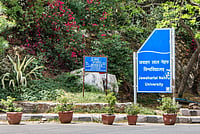The Assam forest department has urged the Centre to take action against an RTI activist who, by “falsely” alleging that it inflated the number of rhinos in the Kaziranga National Park, sought to bring disrepute to the KNP. In reply to a letter to the Ministry of Environment, Forest and Climate Change, Assam's Principal Chief Conservator of Forests and Head of Forest Force, M K Yadav, asserted that RTI activist Rohit Choudhury has “misread” the Standard Operating Procedure (SOP) followed in rhino census. Choudhury had written to the ministry on Wednesday that the Assam forest department inflated the rhino population in KNP in its 2022 census, putting the figure at 2,634 when it should have been 2,042. Terming this a "strange procedural deviation", he also alleged that the enumerators’ data have been deleted.
The ministry sent the complaint to the department seeking an explanation.“He (Choudhury) has defamed the Park by falsely creating propaganda without understanding the procedure and methodology of the estimation exercise. Calling the Kaziranga rhino population estimation 2022 a ‘strange procedural deviation’, Choudhury speaks of his malafide intentions against the Park and his comment on the estimation process is highly lamentable and condemnable,” Yadav said in his reply. The RTI activist had alleged in a letter to the ministry that according to information provided by the Eastern Assam Wildlife Division, a survey was conducted in March last year in 22 randomly selected blocks of KNP, and it showed a rhino population of 1,064 though the enumerators had counted only 472 on March 26 and 27 in those blocks. "It is seen that in the final computation, the enumerators' data pertaining to these 22 blocks were deleted,” and the projected total population in all 80 blocks was shown as 2,634 instead of 2042 which should have been the correct figure, Choudhury said.
He had also claimed that there is no procedure such as 'sample survey' in the Block Count Method which is one of the three methods prescribed for Rhino Population Estimation in the SOP. A ‘sample survey' was conducted in the 22 blocks. Yadav, the forest officer, said Choudhury's allegations were baseless as the process does not involve "actual counting of rhinos" but "counting of rhinos sighted" on March 26 and 27 while on March 28 there was also a recount where the full count could not be achieved on the first day. According to the Union environment ministry, the SOP for "Monitoring of Greater One Horned Rhinoceros Population" points out that "depending on the resources and manpower availability double count in the same area is also practised to minimise errors".
Further, in the SOP, it is advised that a combination of the total count with some suitable sampling procedures like annual birth and death records, regular monitoring records, etc. is necessary to diminish error to find the actual count, Yadav said. An analysis of the estimation exercise over the years since 1991 points to steady growth of the rhino population in KNP and since then till 2022, it has recorded an average annual growth of 2.7 percent. During this period, a total of 714 rhinos died and of them, 51 were killed by poachers.


























